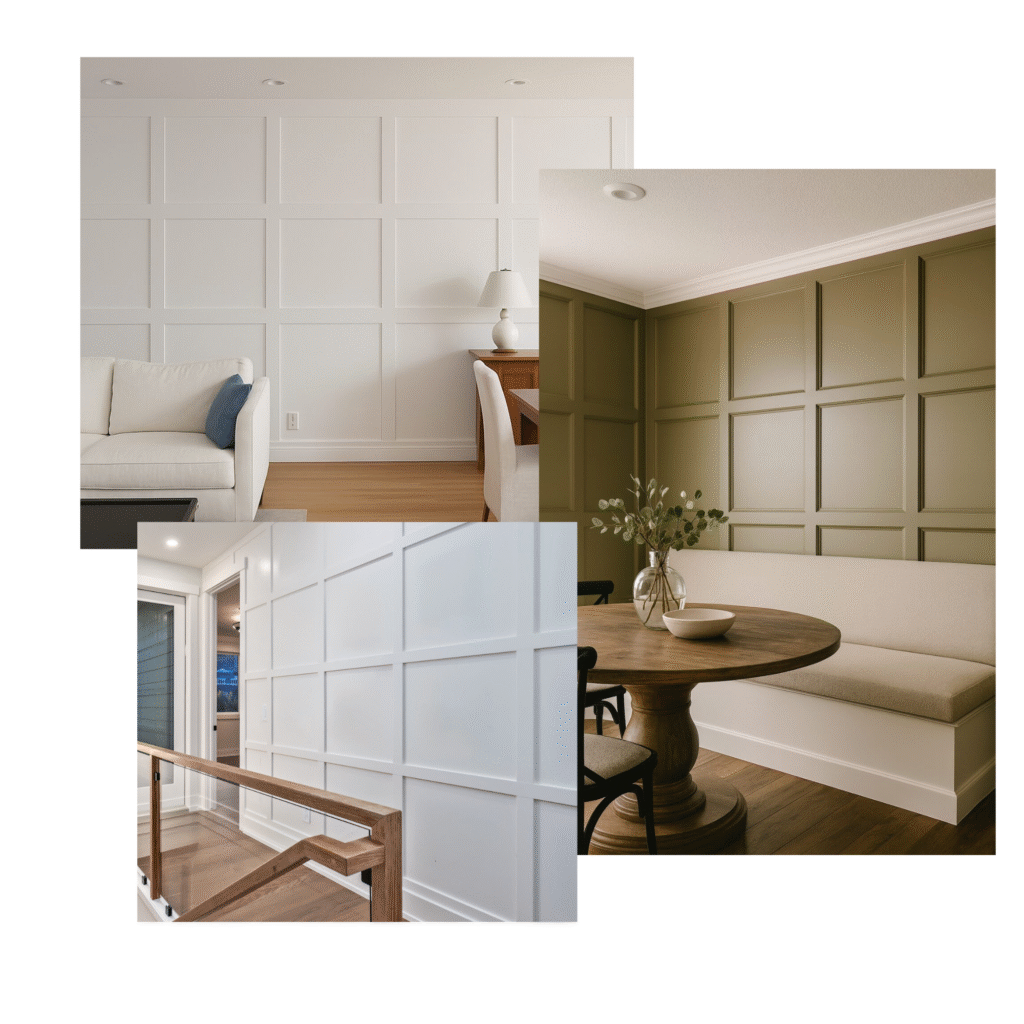Welcome to WordPress. This is your first post. Edit or delete it, then start writing!
When it comes to flooring, choose the right option for your home
When it comes to flooring, there are so many options it can be hard to know what is the right choice. There is no perfect type of flooring as it depends on the home and various conditions. The following post will go over what kind of flooring works in different situations.
Understanding Your Flooring Options
Today there are so many flooring options available. Some people say vinyl plank is the new thing and you should put it everywhere in your house. Still, others say that solid hardwood is the king and that should be everyone’s goal. As an experienced carpenter, I say “It depends.” Each type of flooring has its uses.
The Foundation: Subfloor and Joists
Lets start at the bottom, a typical house will have a concrete slab in the basement, and the floor system on the main and second level is made of wooden joists, with a plywood or OSB subfloor nailed to them. The flooring goes on top of this plywood. In an older house, instead of plywood, they may have used wood boards 4-6 inches wide at an angle to the joists, and sometimes with tongue and groove connections.
The plywood that is typically used today also has tongue and groove connections on the long sides to keep the edges down.
In an older home, squeaky floors are very frequently a problem. This can be because the wood joists have dried out and warped, the subfloor could be inadequately nailed down and lift up, or the joint between the tongues and grooves can move around and cause squeaks. This is why, whenever I remove an old floor covering, I use 1 1/2″ flooring screws to screw the subfloor into the joists every six inches. Most of the time, this fixes the squeak problems.
If the subfloor is removed, for example, to run plumbing, then I will use blocking in between the joists to support both sides of the cut, and I try to cut along the middle of a joist so the plywood is still supported. Then I glue the plywood down with construction adhesive and screw it in.
Increasingly, in new home construction, the subfloor will get glued down and screwed as opposed to the old nails. This makes for a much better floor system. Given the option during a remodel, I will remove the subfloor and glue down the new plywood. Yes, it is an extra cost, but if you are putting thousands into an upgraded floor, why wouldn’t you spend a little more time to get rid of floor squeaks.
Exploring Flooring Options
Laminate Flooring
Laminate flooring is an affordable option, with lots of varieties of colors, and is relatively durable. It’s made from a high-density type of MDF and usually requires an underlay to be rolled out and taped down before use. It will not hold up whatsoever to water because MDF readily absorbs water and expands significantly. The problem is that when the water dries out, the laminate does not contract. This will buckle floors and ruin joints. Most laminate floors are a “floating” system, meaning that they click together and do not need to be glued or nailed in.
Luxury Vinyl Plank (LVP)
Luxury Vinyl Plank is increasingly popular because it can be textured to resemble real wood, is waterproof, and installs easily. It has a built-in underpad, so there is no need to roll out underlay beneath it. It is vinyl, so it is highly water-resistant. I recommend this to my customers for rental properties because it is durable and looks good. It can go in kitchens and bathrooms, so it is simple to use the same flooring throughout the house. I also recommend it to customers with kids and pets who are liable to damage floors.
Hardwood Flooring
Hardwood is the tried and true flooring. In older homes, you will find the typical 1 1/2″-2″ oak flooring in golden oak finish. While this can be sanded and stained to look new, it does not give you the chance to get under the hardwood and fix problems with the subfloor. The nails or cleats used for old floors can work their way loose over time and contribute to a floor that doesn’t feel solid underfoot.
Modern hardwood comes in a variety of species, with oak remaining the most popular. Modern taste dictates wider boards. However, since old-growth trees are increasingly rare, solid hardwood has become more expensive. You can buy pre-finished hardwood or buy it raw and apply stain and finish after it is installed. The natural grain will vary with each piece and give your space a natural look and feel.
Wax paper is used for ease of installation, but is not mandatory. Hardwood has a tongue and groove system similar to subfloors, but on all four sides. It is nailed down at an angle through the tongue with a special nailer and cleats. If you are installing hardwood, don’t skip this step, and don’t try to glue it down. Natural wood expands and contracts significantly based on relative humidity in the environment. If you limit its movement by using glue, the hydraulic pressure of the wood expanding along its width is sure to buckle it somewhere else.
Oak, cherry, ash, and maple are common choices for hardwood floors.
Walnut is a good option although slightly softer, so it is more likely to dent. However, this is a worthwhile tradeoff because the grain is so beautiful. I wouldn’t hesitate to install a walnut floor unless it was in a working farmhouse or a home with lots of large dogs. The longevity of the flooring will depend on if you use a good top coat. I recommend an oil-based polyurethane; it will protect the wood and the finish underneath. If you want a more natural look, try Rubio Monocoat OilPlus2C. It is a two-part system that reacts chemically with the wood to protect it but does not build up a film over the surface of the wood.
Vinyl Sheet Flooring
Vinyl sheet flooring can be found in some bathrooms of older homes. It can be a good option for the right space and provides great waterproofing. It is also common in commercial settings.
Tile Flooring
Tile is the traditional standard for bathrooms and kitchens. It is known for being water-resistant and easy to maintain. Because tile needs to be set in a bed of mortar, it creates a very heavy weight load on the floor system. If the floor is not strong enough, it will deflect and crack the grout joints.
Check with a tile expert if the subfloor needs to be strengthened by adding more material. Cement board is used to give the mortar a surface to grip. Tiles are also available that replicate wood grain, giving you the color and texture of wood without the expansion, contraction, or maintenance.
Tile floors can be cold, so it is popular now to install heating systems under the tile to keep it warm. These can be hot water-based or electrical using elements like an oven. Tile will be built up because of the added material and mortar, so you need to consider that if it is going to transition to hardwood or another type of floor. A good contractor will plan this ahead of time and avoid changes in elevation between floor types.
Carpet Flooring
Carpet is the standard that most new builds come with. Over time, they will wear and eventually need replacing. Carpet comes in huge rolls, and where required, hidden joints are made using special tape. It has a spongy underpad that puts some bounce in it.
Carpet is installed by nailing tack strips on the perimeter of a room. The carpet is stretched and kicked onto the tack strips using a special tool. The underpad is stapled to the floor, and staples are used when carpeting a staircase. Carpet is touted as a “safe” stair covering because it is not slippery and less likely to cause children and the elderly to fall. It’s my belief that having adequate handrails on both sides of a staircase negates the “danger” of smooth stair surfaces.
One problem that arises after removing carpet is that the subfloor is totally full of staples, some of them with little chunks of underpad caught in them. The subfloor needs to be totally clean before floors are installed, so the staples must be pulled. Some people will hammer them in, but they could work loose and cause squeaks. I always remove all staples and vacuum carefully before putting down flooring.
Considerations for Flooring Changes
An important consideration when planning a flooring change is the baseboards and casing. If you go from carpet to Luxury Vinyl Plank (LVP), then it is likely the LVP will not reach the bottom of the baseboard, leaving an unsightly gap. If you remove the baseboard and move it down, then you will have a gap that needs to be repainted. You can replace the baseboard with a taller base, and this will hide the gap in the paint.
The other option is to use quarter-round or another type of trim molding to hide the gap between the base and the flooring. This is common practice for floor installers, but personally, I don’t like the look of quarter-round. I would sooner use base shoe or doorstop moldings, but prefer to avoid it altogether.
I hope this post provides some insight into what type of floor you could use in your house. If you happen to be in Guelph or the surrounding area, give us a call, and we will be happy to help you with any of your flooring installation needs.

